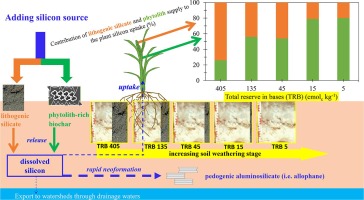Our official English website, www.x-mol.net, welcomes your
feedback! (Note: you will need to create a separate account there.)
Neoformed aluminosilicate and phytogenic silica are competitive sinks in the silicon soil–plant cycle
Geoderma ( IF 5.6 ) Pub Date : 2020-06-01 , DOI: 10.1016/j.geoderma.2020.114308 Zimin Li , Jean-Thomas Cornelis , Charles Vander Linden , Eric Van Ranst , Bruno Delvaux
Geoderma ( IF 5.6 ) Pub Date : 2020-06-01 , DOI: 10.1016/j.geoderma.2020.114308 Zimin Li , Jean-Thomas Cornelis , Charles Vander Linden , Eric Van Ranst , Bruno Delvaux

|
Abstract In soils, mineral weathering and phytolith dissolution release aqueous monosilicic acid that can be taken up by plant, adsorbed on mineral surfaces, entrapped in neoformed clay minerals, or exported to watersheds. The balance between biotic and abiotic processes determines the fluxes of bioavailable silicon (Si), impacting plant growth and health, and diatoms biomass, hence the oceanic capacity to fix carbon dioxide. Here we quantified this balance in an experimental system using rice and an albic soil material (quartz grains) containing no weatherable silicate minerals. Materials representing a soil weathering gradient were prepared by adding variable amounts of silicate minerals within fresh powdered tephrite (
中文翻译:

新生硅铝酸盐和植物硅是硅土-植物循环中的竞争性汇
摘要 在土壤中,矿物风化和植硅体溶解释放出单硅酸水溶液,这些单硅酸可以被植物吸收、吸附在矿物表面、包裹在新形成的粘土矿物中或输出到流域。生物和非生物过程之间的平衡决定了生物可利用硅 (Si) 的通量,影响植物生长和健康,以及硅藻生物量,因此决定了海洋固定二氧化碳的能力。在这里,我们在使用大米和不含耐候性硅酸盐矿物的白质土壤材料(石英颗粒)的实验系统中量化了这种平衡。代表土壤风化梯度的材料是通过在新鲜的粉状绿玉髓中加入不同数量的硅酸盐矿物来制备的。
更新日期:2020-06-01
中文翻译:

新生硅铝酸盐和植物硅是硅土-植物循环中的竞争性汇
摘要 在土壤中,矿物风化和植硅体溶解释放出单硅酸水溶液,这些单硅酸可以被植物吸收、吸附在矿物表面、包裹在新形成的粘土矿物中或输出到流域。生物和非生物过程之间的平衡决定了生物可利用硅 (Si) 的通量,影响植物生长和健康,以及硅藻生物量,因此决定了海洋固定二氧化碳的能力。在这里,我们在使用大米和不含耐候性硅酸盐矿物的白质土壤材料(石英颗粒)的实验系统中量化了这种平衡。代表土壤风化梯度的材料是通过在新鲜的粉状绿玉髓中加入不同数量的硅酸盐矿物来制备的。











































 京公网安备 11010802027423号
京公网安备 11010802027423号